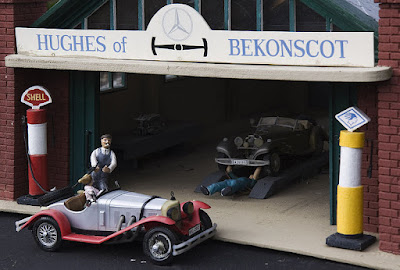Wiki:
Bekonscot in Beaconsfield, Buckinghamshire, is the oldest original model village in the world.
It portrays aspects of England mostly dating from the 1930s. Bekonscot has been run by the Church Army since 1978 and donates large amounts of money to charity. It has raised the equivalent of almost £5,000,000 so far and has been visited by more than 14,000,000 visitors.
Bekonscot was first created by Beaconsfield resident, accountant Roland Callingham (1881-1961), in the 1920s. Roland developed the master plan for his miniature empire as an addition to his large back garden, drawing in help from his staff: the gardener, cook, maid and chauffeur. Together they developed the model landscape portraying rural England at the time. The swimming pool became the first "sea" and the undulating rockeries were built up as hills. Bassett-Lowke, the well-known large-scale model railway manufacturers, were commissioned to build an extensive 7 1/4 in (184 mm) gauge railway network, which exists to this day. Callingham named the village 'Bekonscot' after Beaconsfield and Ascot where he previously lived.
It was not conceived as a commercial visitor attraction but as a plaything to entertain Roland and his guests. It was only after 1930 that its existence became widely known, catching the imagination of the press and public alike. Frequent newsreels such as Pathe, international and national newspaper coverage ensure a steady stream of visitors, all of whom were invited to make a donation to the Railway Benevolent Institution.
Bekonscot is acknowledged to be the inspiration for many other model villages and miniature parks across the world, including Babbacombe, Southport, Madurodam, Bourton-on-the-Water, Wimborne, Great Yarmouth, Clonakilty and Mini-Europe. As such, it is regarded as the "grandfather" of the model village and miniature park movement.
The village expanded in size throughout the first half of the 20th Century. Callingham sold off much of the land surrounding the model village, all of which is now a housing estate. The village is now entirely surrounded by urban development so further expansion is impossible.
Bekonscot popularised the miniature park movement, put Beaconsfield on the map and has a continuing financial legacy in donations to charitable organisations both national and local.
The site is approximately two acres of which just over half is a miniature 1:12 landscape. Buildings are constructed in natural materials, concrete, or dense foamboard; many are originals from the 1920s.
There are six model villages set within the miniature landscape. These are entirely fictional towns, but many buildings within them are based on UK prototypes. Successive generations of modelmakers, gardeners and craftsmen have left their mark on their subjects, which display a wide range of vernacular architectural styles.
Names of shops and other features include some very silly puns, such as Lee Key Plumbers' Merchants and the Mark Owney Wireless and Gramophone stores. Other model villages have run with the playful nature of the miniature businesses and it has become something of a model tradition to continue.
Bekonscot is famed for its complex outdoor model railway (in Gauge 1), possibly the largest public garden railway in the UK, at ten scale miles. A custom-built PC-based interface controls the block signalling system, directing up to 12 trains at any one time on prototypical routes. In addition there are two manual lever frames, one ex-BR and the other from London Underground. The British Rail lever frame is still in use as a manual override for the trains. Some original Bassett-Lowke stock from the 1930s is still in daily use, albeit with new running gear. New locomotives and stock are added annually.
A miniature railway giving passenger rides was built along the perimeter of the site in 2001. Of 7 1/4 in (184 mm) gauge this was extended in 2004 to a new terminus. Three battery-electric locos haul trains: one a Bo-Bo tram, one a Pfeifferbahn-based engine and one a large 0-4-0 built by Maxitrak. The latter was named "Sprocket" in 2004; the third birthday of the railway and the 75th of the Model Village.
Currently there are 12 full-time staff who maintain the village throughout the year; during the open season a further 20 or so seasonal staff are employed.


No comments:
Post a Comment